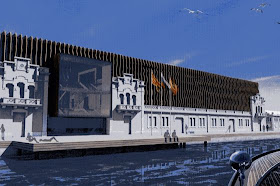News and Opinion
Amid Spain's economic woes, the drama of mortgage foreclosures has captured public and political attention recently.
Since the crisis started, some 400,000 families have been evicted from their homes for defaulting on mortgages, according to estimates. The rate is about 3% of all outstanding home debt -- not an alarming number in economic terms, but staggering in human cost.
Protest movements to halt evictions have been growing, and leftist parties such as Izquerida Unida have for years been calling for major reforms in the harsh eviction laws, which strongly favor banks over homeowners.
This fall, the protesters
In Spain, companies are prohibited from cutting off your water or electricity for failure to pay their bills -- these utilities are considered essential to the right to life and dignity and so forth. But a bank can throw you out of your house for default, even though the right to decent housing is written into the Spanish constitution.
What is more, the subjects of foreclosure have no voice in eviction hearings. And the seizure of the property in question does not necessarily satisfy the debt with the bank. The value of the property is officially appraised and whatever is not covered by its value, including accumulating interest, remains as a debt on the shoulders of the evicted former homeowner. And banks routinely manipulate appraisals downwards in their benefit, according to newspaper articles on the issue.
Families in Spain had few alternatives to high mortgages with floating interest rates in the years of the boom. The rental market here is very limited, while speculation sent home prices soaring.. In an article on November 11, for example,
The New York Times reported on one foreclosure victim, a construction worker who paid US $ 320,000 --a staggering sum here-- for a basement apartment in the working class neighborhood of Carabanchel, and lost it to foreclosure three years after he lost his job.
Despite the pressure, the conservative government has done very little to alleviate the predicament of families facing foreclosure -- in part, according to
El País, due to counter-pressures from banks and Brussels, worried about Spain's general credibility.
The government proposes to pass a two-year moratorium on foreclosures for only a small percent of victims who must meet a number of conditions in terms of income, family size and other factors to qualify as "the most vulnerable" to "social exclusion". Interest on their debt will continue to accrue during the moratorium. And the government has promised to set up a fund of apartments to rent at subsidized prices to evicted families, drawing on Spain's stock of vacant units, although such a government program will probably take years to get going.
What I don't understand is why so much is mobilized to rescue banks, and nothing for the victims of their manipulations. Conservative politicians talk about foreclosure victims in moral terms, as welchers on a business deal --private property always seems to be the most sacred right for conservatives-- but balk at holding banks to the same moral standard.
Wouldn't it be more logical if some of the money sunk into bailing out banks was used to lower mortgage debt and payments for foreclosure victims too? The same money would end up in the banks anyway. Spain' stock of vacant apartments, vagrants and squatters would not continue to grow, and a lot of human suffering would be avoided.
But to enact something so simple and logical, so full of common sense and humanity, would probably take nothing short of a revolution.
Other basic measures should be enacted:
- Fixed interest rate for life of mortgage.
- The house as sole guarantee for the loan.
And the market should consider:
- Conversion of empty units to rentals facilitating long-term occupancy.
- Sale of empty units at real present market value. Banks and owners still resist serious markdowns (except when they are taking over foreclosed properties).
In the
NY Times story, the construction worker in Carabanchel won a temporary reprieve from his bank after protesters, outnumbering the police on the scene:
"By the end of the morning, bank and court officials had agreed to
postpone Mr. Hernández’s eviction for six weeks. He still faces a debt
of more than $330,000, more than he paid for the apartment. In Spain,
mortgage holders are personally liable for the full amount of their
mortgages. Then penalty interest charges and tens of thousands of
dollars in court fees are added at foreclosure. Bankruptcy is no answer,
either — mortgage debt is excluded."
El Pais has a web page dedicated to their ongoing coverage of this issue, which can be found
here.
Link
here to the
Plataforma de Afectados por la Hipoteca or Platform for Those Affected by Mortgages, the popular movement leading opposition to evictions.
A story in
El País on November 24th traces the links between the anti-eviction movement and the 15-M movement:
La lucha antidesahucios, el primer logro del 15-M
Add to these victories against evictions the demonstrations that forced Madrid's regional government to go back on its plan to convert
La Princesa, the noted research hospital, into a geriatrics facility (a plan also criticized by professional associations). And the adventure towards Catalan autonomy sponsored by regional president Artur Más was also inspired by a massive pro-separatist demonstration in Barcelona on September 11th. As in the years of the transition to democracy or the mass protests against Basque terrorism, well-organized public demonstrations are proving again to be a powerful tool for shaping policy in the Spanish democracy.
Is this necessarily positive? Or does it point as well to a fragile rigidity in Spain's democratic institutions, unable to adequately respond to crises, and to the weakness of its politicians, lacking in leadership and vision? As in Catalan separatism, the impulses of the mob are not always so hot. But so far, in their level of civic awareness and active solidarity, popular movements and voters are way ahead of Spain's political class.













